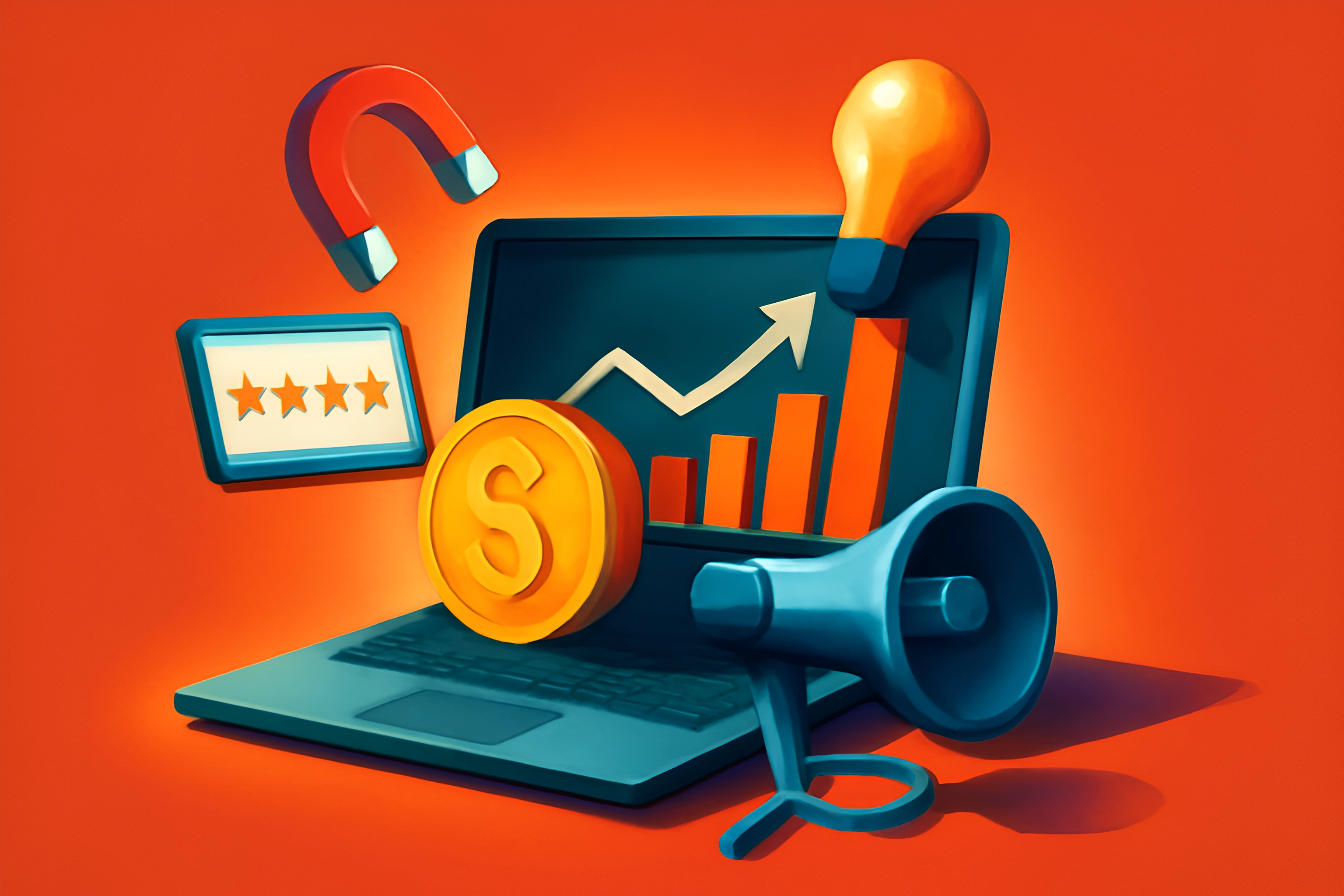
The clock strikes 10 PM. The cold glow of the monitor is your only companion, illuminating a battlefield of a dozen open tabs. You’ve created content, answered a flood of emails, sent three invoices, updated your social media, and tried to troubleshoot a client's problem—all while the big-picture, money-making ideas on your whiteboard gather dust.
This is the solopreneur's dilemma. You're the CEO, the marketer, the accountant, and the customer service rep, trapped in a cycle of manual, repetitive tasks that drain your energy and create crippling bottlenecks. These are the invisible time-sinks, the silent killers of growth that keep your business from scaling beyond your own two hands.
But what if you could clone yourself? What if you could build a digital assistant that never sleeps, never makes a mistake, and handles the grunt work for you? This isn't a complex, corporate buzzword; it's the online entrepreneur's secret weapon. It’s time to integrate digital tools for workflow automation and make your favorite apps "talk to each other," so you can finally focus on what truly matters: creating value and generating income.
Beyond Saving Time: The Real ROI of Automation
Let's be clear: this is about more than just clawing back a few hours. True workflow automation is about fundamentally changing the way your business operates. It’s about building a resilient, scalable engine that works for you, not the other way around.
The real prize is reclaiming your creative energy. When you automate the administrative drag—the copy-pasting, the data entry, the follow-up reminders—you free up your mind for the high-impact work that only you can do. This is the strategy, the innovation, and the connection that grows your brand and your bank account.
Automation also creates a flawless client and customer experience. Imagine a world where no lead is ever dropped, no welcome email is ever missed, and every new customer feels seen and valued—instantly. Automating these touchpoints builds trust and professionalism, turning one-time buyers into loyal fans. According to Atlassian, improved collaboration and task management are key benefits of automation, ensuring your business presents a unified, reliable front to the world.
Finally, this is your ticket to scale your business without scaling your team. Smart automation builds systems that can handle 100 clients as easily as they handle 10. You can grow your revenue and impact without immediately increasing the overhead of new hires. It eliminates the risk of costly human error from manual data entry and forgotten tasks, creating a secure foundation for sustainable growth.
How It Works: Your First Look at Automation Tools
Diving into automation can feel intimidating, but the core concepts are surprisingly simple. You don't need to be a coder or a tech genius to get started. You just need to understand the basic building blocks that make the magic happen.
Native Integrations vs. Third-Party "Connectors"
First, you have Native Integrations. This is when two tools are built from the ground up to work together seamlessly. Think of how your Shopify store can connect directly to your Mailchimp account to add new customers to your email list—that’s a native integration, built right into the software.
Then you have the "connectors"—the powerful third-party platforms that act as the universal glue for the internet. These services are designed to make almost any two apps talk to each other. The two most popular are leading no-code automation platforms that every solopreneur should know.
- Zapier: This is the undisputed king of user-friendly automation. With a massive library of thousands of connected apps and a simple, step-by-step setup, it’s the "Apple" of automation—intuitive, powerful, and perfect for getting started.
- Make (formerly Integromat): For those who want more visual control and power, there's Make. It uses a drag-and-drop interface that lets you build more complex, multi-step workflows, making it the "Android" of automation—customizable and incredibly potent.
The Basic Language: Triggers and Actions
No matter which platform you use, they all speak the same simple language: Triggers and Actions. Think of it as a basic "If this, then that" command for your business. It’s a simple yet powerful formula that forms the basis of every automation you'll ever build.
A Trigger is the event that starts the automation. It’s the "if this happens..." part of the equation. For example, a trigger could be: "A new sale is made on Gumroad" or "A new row is added to a Google Sheet."
An Action is the resulting task that the automation performs. It’s the "...then do that" part. Following our examples, an action could be: "Add the customer's email to a ConvertKit sequence" or "Send a notification to my Slack channel."
Put It Into Practice: 5 Automation Workflows You Can Set Up This Week
Theory is great, but results are better. Here are five practical, real-world automation "recipes" you can build this week to start saving time and earning smarter. Each one solves a common pain point for online entrepreneurs.
Recipe #1: The Content Creator's Dream
The Goal
To streamline content promotion across multiple platforms the moment you hit "publish."
The Tools
WordPress (or your blog), Buffer/SocialBee, Google Drive.
The Automation Recipe
When a new post is published on WordPress...
Then create a series of draft posts in Buffer...
And Then add the post title and link to a "Published Content" Google Sheet.
The Earnist Benefit
This saves 1-2 hours per week on manual social media scheduling and creates a permanent, searchable record of all your content. It's a foundational step to optimize your content creation process for consistent income growth.
Recipe #2: The Freelancer's Client Onboarding Machine
The Goal
To create a professional and seamless onboarding experience for new clients, making you look like a pro from the very first interaction.
The Tools
Stripe/PayPal, Trello/Asana, Google Drive, Gmail.
The Automation Recipe
When a new client pays their initial invoice in Stripe...
Then create a new client board in Trello from a template...
Then create a shared client folder in Google Drive...
And Then send a templated "Welcome Aboard!" email from Gmail.
The Earnist Benefit
This wows clients from day one, eliminates administrative headaches, and ensures no critical onboarding step is ever missed. This level of organization is key to productivity mastery for solopreneurs.
Recipe #3: The Lead Magnet Funnel
The Goal
To automatically capture, tag, and nurture new email subscribers without lifting a finger.
The Tools
Typeform/Gravity Forms, ConvertKit/MailerLite, Google Sheets.
The Automation Recipe
When someone submits your lead magnet form...
Then add them to ConvertKit with a specific tag (e.g., "ebook-download")...
And Then add their name and email to a "New Leads" Google Sheet.
The Earnist Benefit
This ensures immediate delivery of your lead magnet and segments your audience for targeted marketing, leading to higher conversion rates. These are the building blocks for creating powerful affiliate marketing funnels for beginners.
Recipe #4: The E-commerce Sales Notifier
The Goal
To get real-time sales notifications for a motivation boost and track customer data effortlessly.
The Tools
Shopify/Etsy/Gumroad, Slack, your Email Marketing Service.
The Automation Recipe
When a new order is placed in Shopify...
Then send a notification with the order details to a `#sales` channel in Slack...
And Then add the customer to a "Purchasers" list in your email service.
The Earnist Benefit
This provides an instant sales motivation hit for you and your team while building a valuable customer list for future promotions and repeat business. It's a core part of an efficient productivity system for solopreneurs.
Recipe #5: The Simple Finance Tracker
The Goal
To automatically log all your income for stress-free bookkeeping.
The Tools
Stripe/PayPal, Airtable/Google Sheets.
The Automation Recipe
When a new payment is successfully processed in Stripe...
Then create a new record in an Airtable base with the customer name, amount, and date.
The Earnist Benefit
This creates an always-up-to-date income ledger, making tax time significantly less stressful. For a deeper dive, check out our ultimate guide to automating your side hustle finances.
Smart Automation Rules: Getting It Right
Automation is a powerful tool, but like any tool, it needs to be used correctly. A "set it and forget it" mindset can lead to broken workflows and impersonal experiences. Follow these best practices to ensure your automation serves you and your customers effectively.
First, start small. The temptation to automate your entire business overnight is strong, but it's a recipe for disaster. Pick one major pain point—the single most annoying, repetitive task you do each week—and build your first automation around solving it. Success here will build the confidence you need to tackle more complex workflows.
Before you even open Zapier or Make, map out the process manually. Grab a pen and paper and sketch out every single step you currently take to complete the task. This simple act clarifies the exact triggers and actions you need to build, preventing confusion and ensuring you don't miss a critical step. Many visual workflow builders are designed to make this process intuitive.
Finally, and most importantly, know when not to automate. Automation should support human relationships, not replace them. Keep a personal touch on critical client communication, personalized thank-you messages for high-value customers, and handling complaints. The goal is to automate the robotic tasks so you have more time for the human connection that truly builds a business.
Your Business, But on Autopilot
To integrate digital tools for workflow automation is to give your business a scalable, resilient foundation. It’s the ultimate strategy for finally "working on your business, not just in it." You're not just saving time; you're buying back your freedom, your creativity, and your focus.
This isn't about being lazy; it's about being ruthlessly strategic with your most valuable asset: your attention. It’s about building intelligent systems that handle the mundane so you can dedicate your energy to creating, connecting, and growing your income streams. This is how you build a business that serves your life, not the other way around.
What is the #1 repetitive task in your business that you could automate? Share your biggest time-sink in the comments below, and let's brainstorm a solution.














